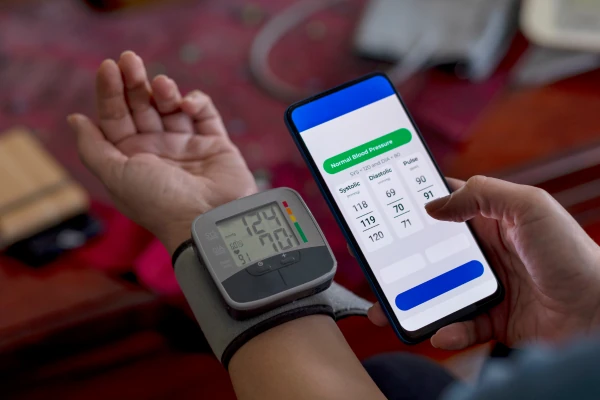Disclaimer: “Remote Monitoring for PTSD: A Comprehensive Guide to Remote Patient Monitoring 2024” is for informational purposes only. It does not constitute medical advice. Consult a healthcare professional for personalized guidance on PTSD and remote patient monitoring.
In recent years, the field of remote monitoring for PTSD (Post-Traumatic Stress Disorder) has seen remarkable advancements, offering innovative solutions to improve patient care and management. These advancements have transformed the landscape of mental health care, addressing longstanding challenges in accessing timely and personalized interventions for individuals coping with PTSD. At the forefront of these advancements is Remote Patient Monitoring (RPM), a technology-driven approach that has revolutionized healthcare delivery for individuals coping with PTSD. RPM offers a paradigm shift in how PTSD can be monitored and managed, leveraging cutting-edge technologies to provide continuous support and intervention, thereby improving patient outcomes and quality of life.
Understanding PTSD and Its Challenges
PTSD is a complex mental health condition characterized by a range of symptoms such as intrusive thoughts, flashbacks, hypervigilance, and emotional numbness. Managing PTSD effectively requires continuous monitoring and personalized intervention, which can be challenging due to various factors including geographical barriers, limited access to mental healthcare professionals, and stigma associated with seeking treatment. Additionally, the heterogeneity of symptoms among individuals with PTSD further complicates diagnosis and treatment planning, highlighting the need for comprehensive and tailored approaches to care.

The Global Impact of PTSD
According to recent statistics, PTSD affects millions of individuals worldwide, with a significant portion of the population experiencing symptoms related to traumatic experiences. The prevalence of PTSD underscores the importance of implementing effective monitoring and management strategies to improve patient outcomes and quality of life. Moreover, the economic burden associated with untreated or poorly managed PTSD, including healthcare costs and productivity loss, highlights the urgency of investing in evidence-based interventions and support services for individuals with PTSD and their families.
The Future of PTSD Care: Embracing Remote Patient Monitoring and AI Integration
As technology and healthcare delivery systems continue to advance, the landscape of PTSD care is on the brink of significant transformation. Projections suggest a notable shift towards Remote Patient Monitoring (RPM) as a primary method for managing PTSD, offering enhanced accessibility, personalized care, and improved outcomes for patients. Additionally, the integration of artificial intelligence (AI) and machine learning algorithms into RPM platforms holds immense promise for early detection of PTSD symptoms, predictive analytics, and personalized treatment recommendations. This integration paves the way for more targeted and efficient interventions, heralding a new era of precision medicine in PTSD care.
Evolution of PTSD Care: Transforming Approaches to Treatment
Over the years, the landscape of PTSD care has witnessed remarkable transformation, driven by advancements in medical technology, shifts in healthcare delivery models, and an enhanced understanding of the condition’s complexities. This evolution has led to the development and adoption of innovative approaches to treatment, tailored to meet the diverse needs of individuals coping with PTSD. Some key aspects of this evolution include:
Integration of technology: From traditional in-person therapy sessions to the integration of Remote Patient Monitoring (RPM) solutions, technology has played a pivotal role in enhancing the accessibility and effectiveness of PTSD care.
Holistic approaches: There has been a shift towards holistic approaches that address not only the symptoms of PTSD but also the underlying factors contributing to the condition, such as social support, lifestyle modifications, and coping strategies.
Personalized interventions: With a growing understanding of the heterogeneity of PTSD symptoms, there has been an emphasis on personalized interventions that take into account individual differences in symptom presentation, treatment response, and comorbid conditions.
Collaborative care models: The evolution of PTSD care has also seen the emergence of collaborative care models that involve multidisciplinary teams of healthcare professionals working together to provide comprehensive and coordinated care to patients.
Emphasis on evidence-based practices: There is increasing recognition of the importance of evidence-based practices in PTSD care, with a focus on interventions supported by rigorous research and clinical evidence.
The Revolutionary Impact of Remote Patient Monitoring in PTSD Management
Remote Patient Monitoring (RPM) revolutionizes the approach to managing PTSD by addressing the limitations of traditional care delivery methods. With the integration of innovative technologies, RPM offers a comprehensive solution that enhances patient care and outcomes. Key aspects of RPM’s role in PTSD management include:
Continuous monitoring: RPM facilitates real-time tracking of vital signs, medication adherence, sleep patterns, and mood fluctuations, providing valuable insights into the patient’s condition.
Accessibility: Through wearable devices and mobile applications, RPM enables patients to participate actively in their care from the comfort of their own homes, overcoming geographical barriers and enhancing accessibility to healthcare services.
Early intervention: By detecting changes in the patient’s condition promptly, RPM allows for early intervention and adjustments to treatment plans, preventing the escalation of symptoms and improving overall health outcomes.
Personalized care: RPM supports the delivery of personalized care plans tailored to the individual needs of each PTSD patient, optimizing treatment effectiveness and patient satisfaction.
Enhanced communication: RPM facilitates seamless communication between patients and healthcare providers, fostering a collaborative approach to care and promoting patient engagement in their treatment journey.
Improved patient engagement: Engagement is a crucial aspect of PTSD management, and RPM plays a vital role in keeping patients actively involved in their care journey. With user-friendly interfaces and interactive features, RPM platforms empower patients to track their progress, set goals, and communicate with their healthcare team, fostering a sense of autonomy and empowerment.

Healthcare Providers Guide: Implementing Remote Patient Monitoring for PTSD Management
Healthcare providers play a crucial role in implementing Remote Patient Monitoring (RPM) for PTSD management effectively. This guide provides essential insights and recommendations for healthcare providers looking to integrate RPM into their practice:
Selection of appropriate technologies: Choose RPM technologies that are user-friendly, scalable, and compatible with existing healthcare systems. Consider factors such as ease of use, data security, and interoperability to ensure seamless integration into clinical workflows.
Integration with Electronic Health Records (EHR): Integrate RPM systems with Electronic Health Records (EHR) to facilitate seamless data exchange and ensure continuity of care. Ensure that patient data is securely transmitted and accessible to authorized healthcare providers, enabling informed decision-making and care coordination.
Training and education: Provide comprehensive training and education to healthcare professionals on using RPM technologies, interpreting patient data, and integrating remote monitoring into clinical practice. Empower patients with the knowledge and skills to use RPM devices effectively, understand the importance of data privacy, and actively participate in their care journey.
Care coordination and collaboration: Foster interdisciplinary collaboration and care coordination among healthcare providers involved in the patient’s treatment. Establish clear communication channels and protocols for sharing patient data and coordinating interventions, ensuring a holistic and integrated approach to PTSD management.
Frequently Asked Questions
What is Remote Patient Monitoring (RPM), and how does it apply to PTSD care in 2024?
Remote Patient Monitoring (RPM) involves the use of technology to monitor patients’ health remotely. In 2024, RPM is a game-changer in PTSD care, enabling continuous monitoring of vital signs, medication adherence, and behavioral indicators through wearable devices, mobile applications, and telehealth platforms.
How does RPM improve accessibility to PTSD care?
RPM eliminates geographical barriers by allowing patients to receive real-time monitoring and support regardless of their location. This enhanced accessibility ensures that individuals living in remote or underserved areas have access to timely intervention and support from healthcare providers.
What are the key benefits of RPM in PTSD management?
RPM offers several benefits in PTSD management, including enhanced access to care, personalized care plans, improved patient engagement, and early intervention and crisis prevention through continuous monitoring of physiological and behavioral indicators.
How does RPM empower patients in managing their PTSD?
RPM empowers patients by providing them with user-friendly interfaces and interactive features that enable them to track their progress, set goals, and communicate more frequently and seamlessly with their healthcare team. This empowerment fosters a sense of autonomy and engagement in their care journey.
What technologies are used in RPM for PTSD care in 2024?
In 2024, RPM for PTSD care utilizes a range of innovative technologies, including wearable devices, mobile applications, and telehealth platforms. These technologies enable continuous monitoring of vital signs, medication adherence, and behavioral indicators, facilitating personalized and proactive care for individuals with PTSD.
How does RPM support healthcare providers in managing PTSD patients?
RPM provides healthcare providers with real-time insights into patients’ condition, allowing for early detection of changes and prompt intervention. Additionally, RPM facilitates seamless communication and collaboration among healthcare providers, enhancing care coordination and patient outcomes.
Is RPM secure and compliant with patient privacy regulations?
Yes, RPM platforms prioritize patient privacy and data security, adhering to stringent regulatory requirements such as HIPAA (Health Insurance Portability and Accountability Act). Data transmission and storage are encrypted to ensure the confidentiality and integrity of patient information.
How can healthcare providers implement RPM for PTSD management?
Healthcare providers can implement RPM for PTSD management by selecting appropriate technologies, integrating RPM systems with Electronic Health Records (EHR), providing training and education to healthcare professionals and patients, and fostering interdisciplinary collaboration and care coordination among healthcare providers involved in the patient’s treatment.
Revolutionizing DrKumo Remote Patient Monitoring Solution for PTSD
Remote Patient Monitoring (RPM) holds tremendous promise in revolutionizing the management of PTSD by overcoming traditional barriers to care delivery and empowering patients to take an active role in their treatment journey. By leveraging innovative technologies and personalized care approaches, RPM enables early intervention, enhances patient engagement, and ultimately improves health outcomes for individuals living with PTSD.
DrKumo RPM Solution as an innovative platform represents a significant advancement in remote monitoring technology, designed specifically to meet the unique needs of individuals coping with PTSD. DrKumo RPM Solution offers a user-friendly interface, seamless integration with wearable devices, and advanced analytics capabilities, providing clinicians with real-time insights and empowering patients to take an active role in managing their condition.
Contact us today to learn more and embark on your journey towards improved mental health and quality of life.










